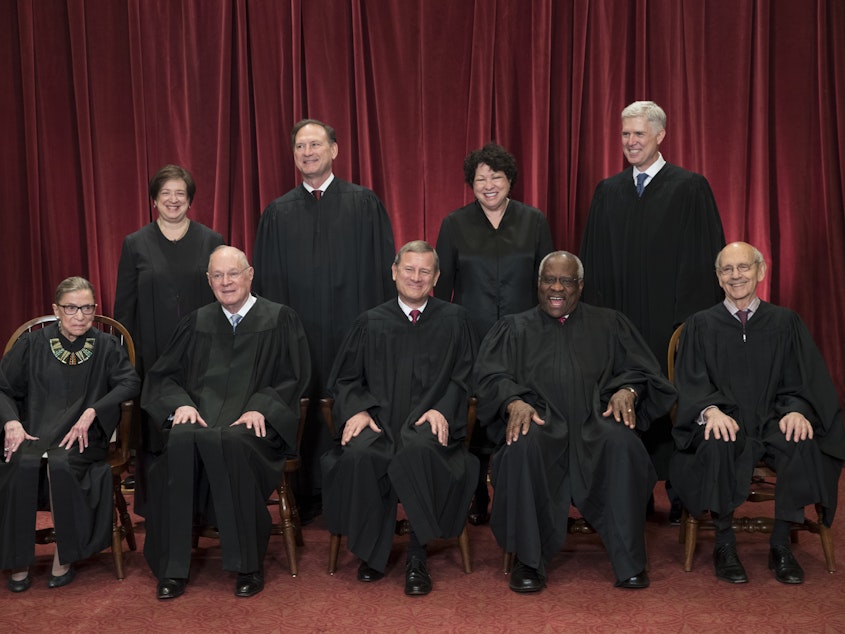Supreme Court Guarantees Right To Unanimous Verdict In Serious Criminal Trials

What does the right to a unanimous jury verdict have to do with abortion, or school prayer, or federal environmental regulations? Stay tuned.
The U.S. Supreme Court Monday struck down state laws in Louisiana and Oregon that allowed people accused of serious crimes to be convicted by a non-unanimous jury vote. The 6-to-3 decision overturned a longstanding prior ruling from 1972, which had upheld such non-unanimous verdicts in state courts.
And these days, any decision to overturn a longstanding precedent rings the alarm bells in the Supreme Court.
In the short run, Monday's decision was a victory for Evangelisto Ramos, who in 2016 was convicted of second-degree murder by a jury vote of 10-to-2 in Louisiana.
Only two states--Louisiana and Oregon--had provisions allowing non-unanimous verdicts, and Louisiana just recently changed its law to be like those in 48 other states and the federal government.
Sponsored
Justice Neil Gorsuch, writing for the majority, laid out the history behind the laws in both states. Gorsuch noted that the measure was first added to the Louisiana state constitution in 1898, after the Supreme Court ruled that racial minorities could not be barred from juries; that same year, Louisiana added the non-unanimous jury provision to its state constitution as part of a package of amendments that deliberately made it difficult for black citizens to vote or otherwise participate meaningfully in the state's governance. Specifically, Gorsuch said, the non-unanimous jury provision was a way to ensure that even if one or two African Americans made it on to a jury, their participation would be "meaningless."
The adoption of the non-unanimous jury rule in Oregon, Gorsuch wrote, "can similarly be traced to the rise of the Ku Klux Klan and efforts to dilute the influence of racial and ethnic and religious minorities on Oregon juries."
Despite these state provisions, there has never been any dispute that the unanimous jury requirement applies to the federal government. The question in this case was whether that aspect of the Sixth Amendment right to a jury trial applied to the states as well.
Over the last 75 years or so, the court has applied just about every other provision of the Bill of Rights to the states, but in 1972 it deviated from that practice, declining to apply the unanimous jury requirement in a similar fashion.
On Monday, however, the 1972 decision came tumbling down. The six-justice court majority — composed of conservatives and liberals — said the earlier ruling was a mistake.
Sponsored
The decision, written by the conservative Gorsuch, was joined in whole or in part by liberal Justices Ruth Bader Ginsburg, Stephen Breyer, Sonia Sotomayor, and conservative Justice Brett Kavanaugh. Justice Clarence Thomas, another conservative, agreed with the result, but on entirely different grounds.
Writing for the dissenters, Justice Samuel Alito — joined by Chief Justice John Roberts and for the most part, Justice Elena Kagan — maintained that the principle of adhering to precedent should be followed in this case because to do otherwise would require "a potentially crushing" number of new trials for people currently imprisoned under the old rule.
"Where is the justice in that?" replied Justice Gorsuch. "Not a single member of this court" is prepared to say that the 1972 decision was correct, he noted. "Every judge must learn to live with the fact that he or she will make mistakes ... But it is something else entirely to perpetuate" a wrong "only because we fear the consequences of being right."
The consequences of Monday's decision will likely be felt more in Louisiana, which allowed non-unanimous verdicts for more serious crimes than Oregon. The court's decision will require retrials for any prisoner who still has appeals pending.
There are about 100 of those cases in Louisiana, says Jamila Johnson, the managing attorney at the Promise of Justice Initiative, which represented Ramos. But there are also at least 1,700 prisoners in the state who might qualify for a new trial if the court eventually holds that Monday's decision is retroactive.
Sponsored
The high court left that question open for another day.
Altogether the majority, concurring, and dissenting opinions totaled a whopping 86 pages and reflected an important subtext--divergent views about when the court should follow its usual rule of adhering to precedent and when it should not.
It's important because, the new ultra-conservative court majority has very different views than the courts of the last 75 years on topics as diverse as abortion, voting rights, federal regulation, and the clash between religious views and generally applicable laws.
"The court's views about when it's OK to overrule prior precedent have always been more about the eye of the beholder than they have been about a rule that is easy or straightforward to apply," says Deborah Pearlstein, professor and co-director of the Floersheimer Center for Constitutional Democracy at Cardozo School of Law. Ultimately, she said, "all of these major questions that are coming before the court are going to be fought along these lines." [Copyright 2020 NPR]


